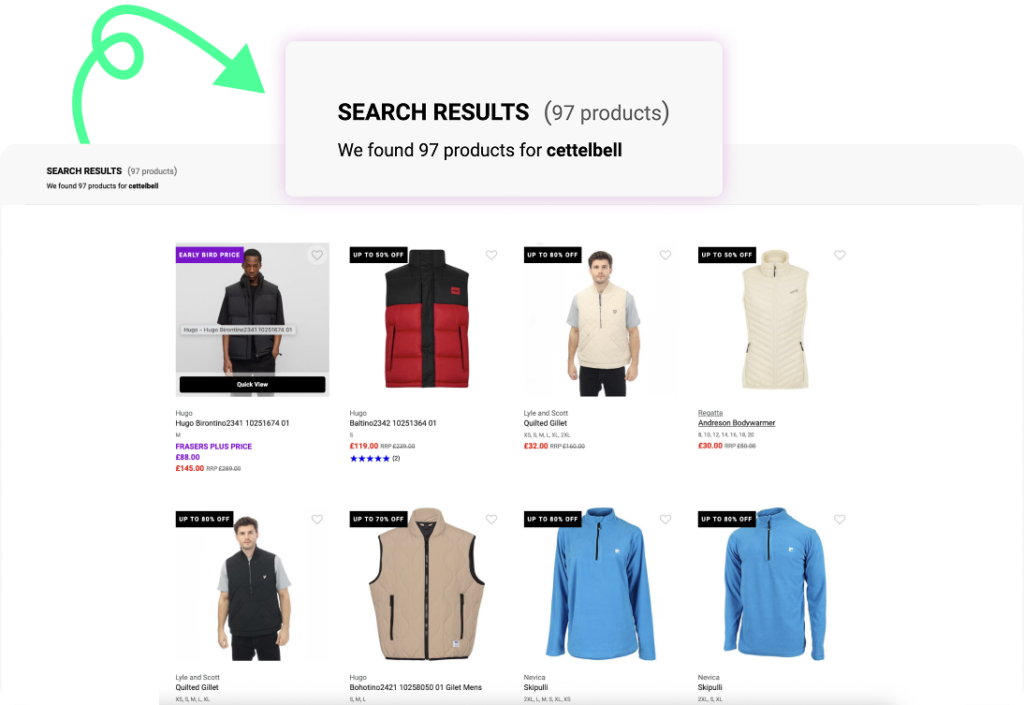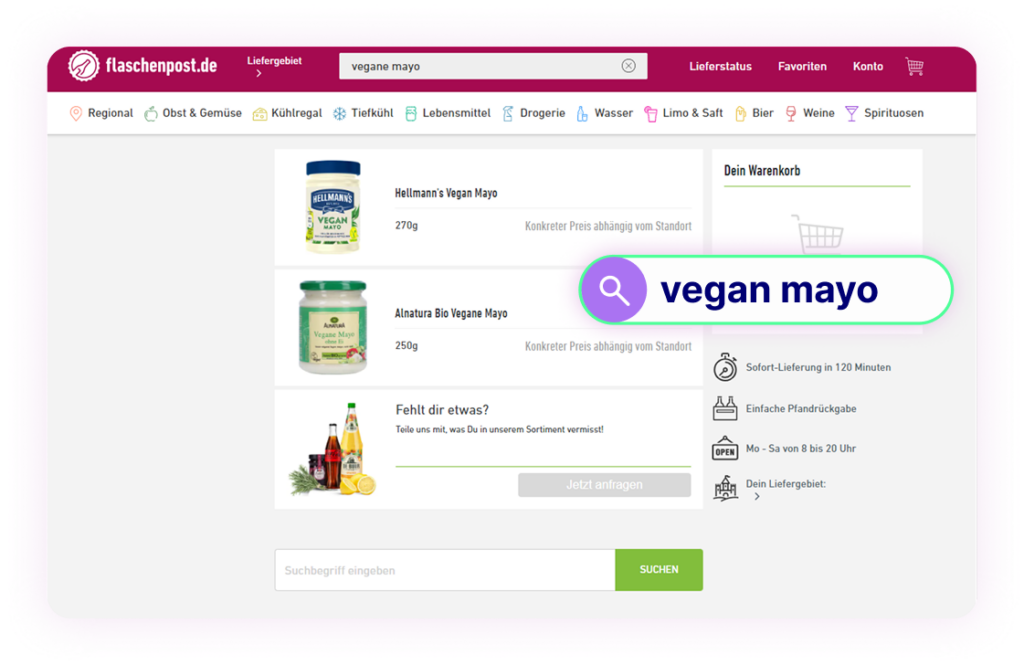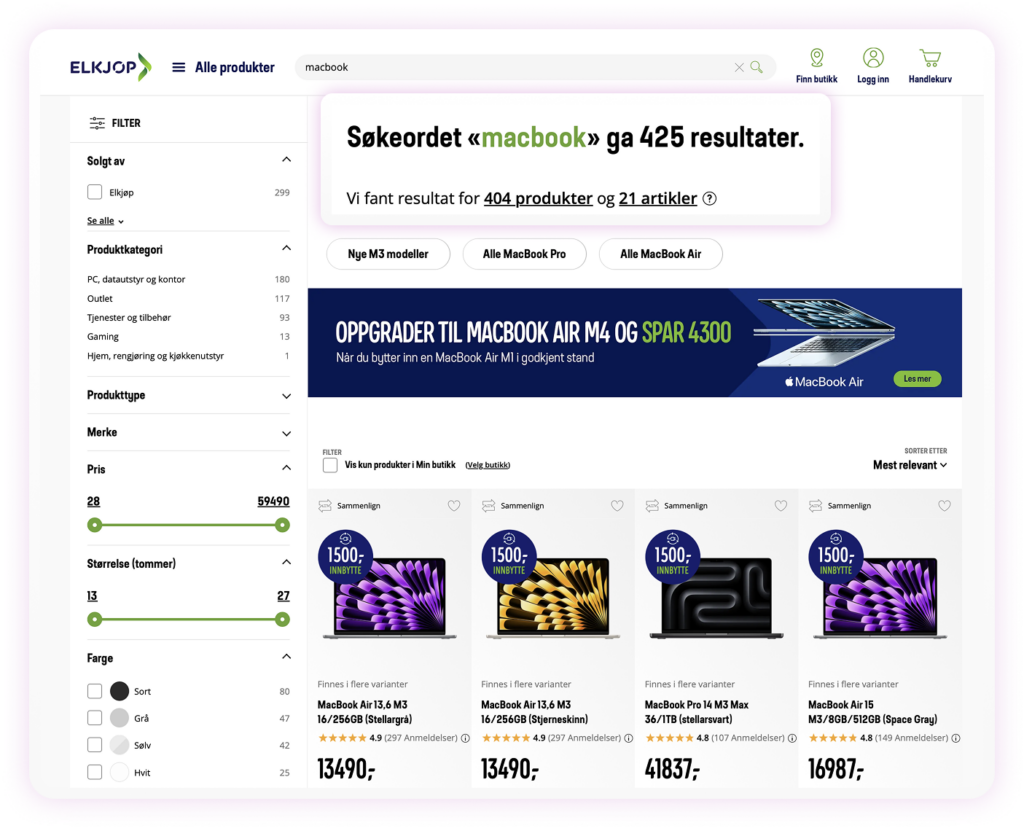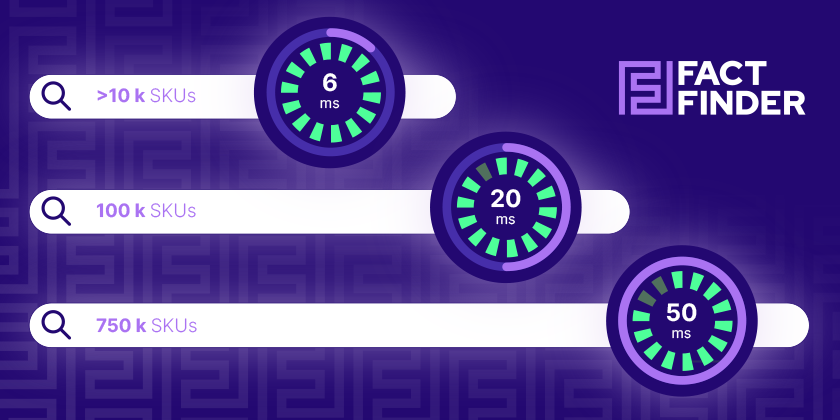Not getting the sales you hoped for? Chances are you’re making some small but avoidable eCommerce mistakes. Even tiny oversights can snowball into a poor online shopping experience and serious lost revenue. Time to fix them.
With eCommerce competition at an all-time high and consumers’ expectations growing by the day, a “good enough” online shopping experience isn’t good enough. Even the smallest pitfalls can lead to missed opportunities, lower conversion rates and lost customers. The good news? They’re easy to fix. Read on to learn how to turn typical errors into high-value sales and long-term customer loyalty.
eCommerce mistake #1: overlooking spelling mistakes

Too many online shops lose sales by not optimizing for typos and spelling mistakes. This store, for example, offers several kettlebells. But when a shopper searches with the phonetic spelling “cettelbell,” they’re shown gilets. Patient customers might try again. More often, though, they’ll give up when they don’t get the right results straight away, or simply assume the store doesn’t offer kettlebells, and head to a competitor. Don’t let typos stop a sale.
Solution: error-tolerant site search
Turn clumsy typers into paying customers by ensuring your search can handle typos, spelling errors, synonyms and multiple languages.
Kübler Sport’s error-tolerant site search makes shopping feel effortless. When a customer types in “cettelbell,” the search returns relevant results, helping them find the right products faster. This lowers bounce rates, speeds up the path to purchase and creates an online shopping experience that keeps people coming back. Discover how Kübler Sport boosted conversions by 35% with advanced product discovery.
“Customer frustration has significantly decreased and we continue to receive positive feedback both externally and internally.” — Marvin Wagner, Online Marketing & eCommerce Manager, Kübler Sport
eCommerce mistake #2: cluttering results with irrelevant and unavailable items
Cluttering search results with unavailable and irrelevant products just creates barriers between shoppers and the items that are in stock. Why show visitors items they can’t actually buy or that vary wildly from their query? It just means they have to scroll to find the right products — and even further if they’re using a mobile. Most visitors will bounce before they see the relevant products you offer. Say goodbye to another potential customer.
This is exactly the problem Germany’s leading rapid food delivery service, Flaschenpost, struggled with before switching from open source to FactFinder. With thousands of SKUs in their database and manual ranking rules, their search often prioritized irrelevant products, resulting in frustrated customers and lost sales.
“When I as a customer enter ‘vegan mayo,’ I don’t want to see 48 different mayonnaises, of which the right product might show up in position 24. Rather, I want to see in the search results exactly the two vegan mayonnaises that are in the range.” — Aron Spohr, CTO, Flaschenpost
Solution: AI ranking rules
Getting the right products in front of your customers is crucial. AI ranking rules makes this easy, automatically displaying the most relevant items for every search. Since switching to a product discovery solution with a sophisticated ranking system, Flaschenpost can now help customers quickly find the right products from their extensive catalog.

“It’s a noticeable difference. You find the products you need at the top of the results.” — Aron Spohr, CTO, Flaschenpost
By sorting products based on relevance, popularity and availability, Flaschenpost delivers an enjoyable online shopping experience that drives conversions and customer loyalty. Find out how Flaschenpost transformed its UX.
For businesses that want more control, FactFinder offers the perfect balance of AI automation and manual rule-setting. The intuitive interface makes it easy to tweak ranking rules. You can highlight featured brands, set up campaigns and hide irrelevant results, optimizing the customer experience while meeting your marketing goals.

Want a more visual explanation?
Hit play on this dynamic demo experience to see how FactFinder works, from the transparent backend interface to the smooth online shopping experience.
eCommerce mistake #3: uninspiring search suggestions
This online store ticks the box of suggesting relevant products before customers finish typing their search query. But the plain presentation hinders the experience. Visitors have to scroll to see the featured categories, brands, ideas and advice. While they’re not making a mistake, this retailer is overlooking key chances to instill excitement and inspire sales.
Solution: smart suggestions that sell
Bring the excitement back to online shopping by showing relevant product suggestions from just two typed letters. Boost their impact with images, ratings, pricing and links to matching categories.
At OBI, searching for “pool” also brings up helpful content, like how-to articles and inspirational tips. This intelligent menu does more than save time. It helps shape the search and opens up new paths the customer may not have thought of.
eCommerce mistake #4: irrelevant filters
Are you losing customers by not providing enough relevant filters? Most people shop with certain preferences in mind. If they can’t easily narrow down their search, they get frustrated and leave, especially in shops with large product ranges.
This shop selling house plants only offers basic filters: color, type and price. But that ignores what customers really care about. Plant lovers also like to filter by things like size, sunlight requirements and maintenance needs. Without these options, potential customers are left scrolling and can easily become overwhelmed. Another sale lost.
Solution: relevant filters, relevant results
Help shoppers find the right product quickly with dynamic filters, which self-learn with every interaction. For example, you might provide a simple check mark system that helps refine search step by step. The more filters clicked, the more criteria applied, resulting in highly-relevant items.
Gärtner Pötschke has taken its on-site navigation to the next level with filters that adapt to each search. Irrelevant options, like lifespan or heyday, are hidden when someone looks for “plant pots.” Even the price range adjusts automatically to match the product category. This creates a smooth online shopping experience where customers find what they need in just a few clicks. They’re also likely to feel more confident in their purchase decision, leading to higher conversion rates and fewer returns.
5-minute checklist: Evaluate your search and discover untapped revenue potential

eCommerce mistake #5: sub-standard customer support
Whether a customer is shopping for themself or someone else, choosing the right product can be hard. Sometimes, they need help. Here’s where most eCommerce businesses fall short. While physical retailers offer trained sales advisors ready to help people the moment they walk through the door, online shops can leave their visitors feeling lost.
Solution: 24/7 life-like customer service with AI sales advisors
Until recently, it was nearly impossible for online shops to provide truly helpful advice without a person at the other end. But now you can. AI Guided Selling automatically generates interactive product advisors in seconds. Just like an expert in-store assistant, your shop can ask the right questions, tailor results to each shopper and guide them to the ideal product, all without the manual set-up work.
Through guided selling campaigns, the leading electronics retailer, Elkjop, turns typically non-converting searches into sales. Its digital consultant helps shoppers make technical product decisions by asking simple questions about the type and style of product they’re looking for. Not only does this improve conversion rate and customer satisfaction, but it also minimizes returns, because customers are more involved in the product selection process.

Prior to introducing guided selling, shoppers struggled to find the right products. But now, even the most clueless customers easily find their ideal device. See the before and after.
Get a closer look at AI Guided Selling in our quick demo video
eCommerce mistake #6: boring landing pages
Landing pages are your store’s chance to shine. They need to engage and convert the customer. Unfortunately, this shop didn’t get the memo. Typing in “Columbia” leads to a jumble of mixed products. With no organization, shoppers can’t tell what’s old, new or trending.
Solution: high-impact visual merchandising
The best stores know how to create spaces that inspire and excite. Just like physical retailers carefully curate their displays, eCommerce businesses can use strategic visual merchandising to make shopping online both fun and memorable.
To get the most out of your campaigns, feature promoted products across your site. This creates intrigue and prompts impulse purchases.
Bergfreunde knows popular labels sell better when they’re grouped together. Searching for “Columbia” takes shoppers to a dedicated branded landing page. They immediately see the bestsellers and can narrow down the selection by category, price or article type. Learn the secret to Bergfreunde’s success.
“I want to have the coolest store in the outdoor industry. With FactFinder, we have found a partner that sets the same high standards for its services and products as us.” — Melanie Giebler, Teamlead Product Management, Bergfreunde
eCommerce mistake #7: forgetting about SEO
How can shoppers find your store if you’re not ranking for the top products you sell? The online shopping experience begins before the customer lands on your site. Whether they’re searching on Google, Bing or TikTok, users don’t want to scroll far to find the item or brand they’re looking for. So if you’re not optimizing your website for search engines, you’re missing out on high-intent visitors.
Solution: rich content and SEO optimization
Give your site the best chance of ranking high in search results by creating rich content that matches what people are looking for. Google prioritizes pages with relevant, valuable information, so make sure your landing pages are helpful and easy to navigate. If you sell popular brands, create branded landing pages with strong headlines, compelling visuals, and well-structured meta data.
Including the brand name and other keywords naturally throughout the page helps Google understand what it’s about — like Bergfreunde does with Columbia. Thanks to the store’s active promotion of Columbia through creative campaigns and branded content, Google lists them as the 4th result on the first page.
eCommerce mistake #8: weak recommendations
Product pages do more than inform. They sell. This is the perfect place to spark interest in related items and drive cross-sells. But in this online store, the related products shown with a luxury knitted cardigan are just generic alternatives, causing choice overload rather than adding value. With a smarter approach, the retailer could highlight pieces that style well together and encourage a bigger basket.
Solution: tailored, timely recommendations
Boost every shopper’s average order value (AOV) by providing tailored, timely recommendations. Highlight items that compliment products the shopper has looked at. When your recommendations feel personal and on-point, they’re more likely to add to their cart.
Mytheresa does this brilliantly. The retailer offers relevant and thoughtful recommendations alongside this cardigan, showcasing pieces that complete the look. These visually engaging suggestions feel curated and personal, helping customers imagine the full outfit and inspiring them to build a complete wardrobe, rather than stopping at a single item. With AI personalization, your recommendations can work the same way: dynamic, personal and based on real-time cart content and customer preferences.
eCommerce mistake #9: poor personalization
Only a small number of online shops offer personalized search results. This is wasted potential as it‘s a significant factor in pleasing and converting customers. According to McKinsey, 76% of consumers are more likely to consider purchasing from brands that personalize, and 78% are more likely to make repeat purchases.
Take this example: a new customer, Lizzie, searches for an “LG TV”, clicks on one of the suggestions and shortly after, runs a search for “Samsung”. On most sites, this would bring up a random selection of Samsung products, perhaps ranked by popularity or current promotions. To find TVs, Lizzie would have to refine her search or scroll through unrelated items.
Solution: real-time personalization
AI-powered real-time personalization ensures your store always shows the most relevant results for each customer at that moment in time.
In this instance, the engine would pick up on Lizzie’s interest in TVs. So instead of showing her a mishmash of Samsung items, it would rank the TVs at the top, matching her search intent and speeding up the path to purchase.
What’s more, you don’t need heaps of data to tailor the experience, even for first-time customers. Shoppers use clicks, filters, baskets, wish lists and search terms to tell you what they want. Personalization shows them you’re listening.
eCommerce mistake #10: slow-loading results
If product search results take more than a few seconds to load, your customers will bounce. Even some of the biggest eCommerce businesses fall victim to this mistake, but that doesn’t mean you can let it go unfixed.
Solution: high-performance site search
With over 90,000 products in its range, REIFF’s catalog overwhelmed its open source search solution. Results would take forever to buffer and potential customers would leave before seeing any products. By integrating a reliable, high-performance search solution, they were able to speed up response times to as little as 6 milliseconds. Uncover the full impact FactFinder has had on Reiff’s business.
“FactFinder has fully met our expectations, both in terms of the project and the performance of the solution.” — Lina-Marie Flores, eCommerce Manager, REIFF

Is your online shop guilty of these mistakes?
These eCommerce mistakes are easy to overlook, but they’re just as easy to fix. With the right tools and a focus on your customers, you can turn frustration into conversion and missed opportunities into long-term loyalty.
Let’s take a look at your site together. Hit the banner below for a free audit and tailored demo that shows what’s possible.
